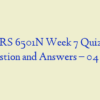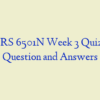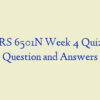Description
NURS 6501N Week 5 Quiz – Question and Answers
- A newborn baby is severely cyanotic. An echocardiogram reveals transposition of the great arteries. A nurse assesses for which of the following, as it usually occurs with this defect?
- A 30-year-old female presents to her primary care provider with fever, cardiac murmur, and petechial skin lesions. When does the patient want to know what caused the disease, what is the nurse’s best response? The most likely cause of the disease is:
- A 67-year-old female was previously diagnosed with rheumatic heart disease. Tests reveal lipoprotein deposition with chronic inflammation that impairs blood flow from the left ventricle into the aorta. Which of the following is the most likely diagnosis recorded on the chart?
- While planning care, the nurse remembers which principle?
- What factors make a patient prone to neurogenic shock?
- A 15-year-old male who is allergic to peanuts eats a peanut butter cup. He then goes into anaphylactic shock. Which assessment findings will the nurse assess for?
- For an infection to progress to septic shock, which of the following factors should the nurse determine occurred?
- A 55-year-old male died of myocardial infarction. Autopsy would most likely reveal:
- A 3-year-old male is diagnosed with Kawasaki disease. Which of the following does the nurse suspect is the most likely cause?
- An 8-week-old infant presents to her primary care provider for a well-baby check. A physical exam reveals a murmur, and an echocardiogram shows a large ventricular septal defect. If left untreated, what condition should the nurse discuss with the parents?
- One consequence of switching from aerobic to anaerobic cellular metabolism during shock states is:
- A 72-year-old female has a history of hypertension and atherosclerosis. An echocardiogram reveals backflow of blood into the left ventricle. Which of the following is the most likely diagnosis documented on the chart?
- Upon assessment of the patient, the nurse finds a widened pulse pressure and throbbing peripheral pulses. Which valve disorder does the nurse suspect?
- Another infant undergoes an echocardiogram for a suspected heart defect. So, tests reveal an opening in the middle of the atrial septum. What term would the nurse use to describe this defect?
- A 72-year-old female has a history of right heart failure caused by a right ventricular myocardial infarction. So, which of the following symptoms are specifically related to her right heart failure?
- A 28-year-old female presents to the ER reporting severe chest pain that worsens with respirations or lying down.
- She has a fever, tachycardia, and a friction rub. Based upon the assessment findings, the nurse determines the patient is experiencing:
- A 42-year-old female is diagnosed with constrictive pericarditis. The nurse assesses the blood pressure for decreased cardiac output because of:
- She asks the nurse to explain where the infection is. In providing an accurate description, the nurse states that the pericardium is:
- A newborn child has a murmur and cyanosis. Another echocardiogram reveals that the tricuspid valve failed to develop and no blood flows between the right atrium and ventricle. What term will the nurse use to describe this condition? Tricuspid:
- A 1-month-old infant visits his primary care provider for a well-baby check. Physical exam reveals decreased cardiac output, hypotension, tachycardia, and a loud murmur suggestive of aortic stenosis. Which of the following would be expected with this diagnosis?
- A 2-week-old infant presents with poor feeding, fatigue, dyspnea, and a murmur. She is diagnosed with a patent ductus arteriosus (PDA). A nurse recalls this condition results in a(n):
- A 1-month-old infant was diagnosed with truncus arteriosus (TA) with a ventricular septal defect. Which of the following would the nurse also expect? (nurs 6501n week 5)
- Which set of assessment findings would the nurse expect the patient to exhibit?
- Which is the most common type of congenital heart defect the nurse should assess for in infants?
- A nurse is teaching staff about endocarditis. Which information should the nurse include? Inflammatory cells have difficulty limiting the colonization of microorganisms in infective endocarditis because the:
- A nurse is teaching a patient about anaphylactic shock. Which information should the nurse include? The onset of anaphylactic shock is usually:
- A 20-year-old male underwent an echocardiogram to assess chest pain. Results revealed a congenital defect in papillary muscles. Which of the following would the nurse expect to occur?
- A 10-year-old male presents with fever, lymphadenopathy, arthralgia, and nose bleeds. While planning care, which characteristic changes should the nurse remember? (nurs 6501n week 5)
- A 75-year-old obese female presents to her primary care provider reporting edema in the lower extremities. Physical exam reveals that she has varicose veins. Upon performing the history, which of the following is a possible cause for the varicose veins?
- When a patient with left heart failure starts to have a cough and dyspnea, which principle should the nurse remember? Pulmonary symptoms, common to left heart failure, are a result of:
- So, check out our latest Tutorials and Courses on BUSI 435.











